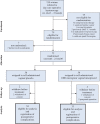A combination of misoprostol and estradiol for preoperative cervical ripening in postmenopausal women: a randomised controlled trial
- PMID: 20002369
- PMCID: PMC2805871
- DOI: 10.1111/j.1471-0528.2009.02435.x
A combination of misoprostol and estradiol for preoperative cervical ripening in postmenopausal women: a randomised controlled trial
Abstract
Objective: To compare the impact of 1000 microg of self-administered vaginal misoprostol versus self-administered vaginal placebo on preoperative cervical ripening after 2 weeks of pretreatment with estradiol vaginal tablets in postmenopausal women prior to day-care operative hysteroscopy.
Design: Randomised, double-blind, placebo-controlled sequential trial.
Setting: Norwegian university teaching hospital.
Population: Sixty-seven postmenopausal women referred for day-care operative hysteroscopy.
Methods: The women were randomised to receive either 1000 microg of self-administered vaginal misoprostol or self-administered vaginal placebo on the evening before day-care operative hysteroscopy. All women had administered a 25-microg vaginal estradiol tablet daily for 14 days prior to the operation.
Primary outcome: preoperative cervical dilatation at hysteroscopy.
Secondary outcomes: difference in dilatation at recruitment and before hysteroscopy, number of women who achieved a preoperative cervical dilatation of 5 mm or more, acceptability, complications and adverse effects.
Results: The mean cervical dilatation was 5.7 mm (SD, 1.6 mm) in the misoprostol group and 4.7 mm (SD, 1.5 mm) in the placebo group, the mean difference in cervical dilatation being 1.0 mm (95% CI, 0.2-1.7 mm). Self-administered vaginal misoprostol of 1000 microg at home on the evening before day-care hysteroscopy is safe and highly acceptable, although a small proportion of women experienced lower abdominal pain.
Conclusions: One thousand micrograms of self-administered vaginal misoprostol, 12 hours prior to day-care hysteroscopy, after 14 days of pretreatment with vaginal estradiol, has a significant cervical ripening effect compared with placebo in postmenopausal women.
Figures
References
-
- Liggins GC. Cervical ripening as an inflammatory reaction. In: Ellwood DA, Anderson ABM, editors. Cervical Ripening as an Inflammatory Reaction: Clinical and Biochemical Investigation. Edinburgh: Churchill Livingstone; 1981. pp. 1–9.
-
- Fiala C, Gemzell-Danielsson K, Tang OS, von Hertzen H. Cervical priming with misprostol prior to transcervical procedures. Int J Gynaecol Obstet. 2007;99(Suppl. 2):S168–71. - PubMed
-
- Grimes DA, Schulz KF, Cates WJ., Jr Prevention of uterine perforation during curettage abortion. J Am Med Assoc. 1984;251:2108–11. - PubMed
Publication types
MeSH terms
Substances
LinkOut - more resources
Full Text Sources



